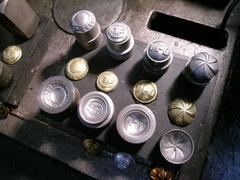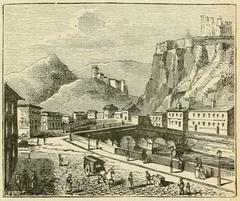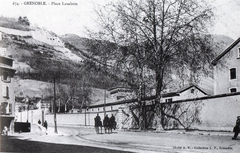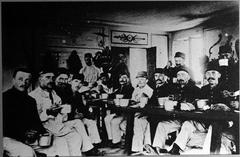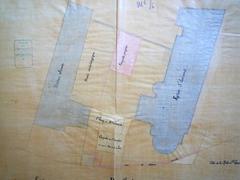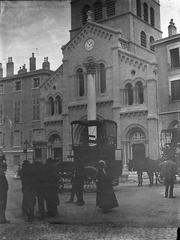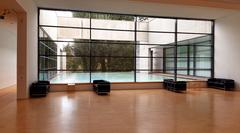
Le Magasin des Horizons Grenoble: Complete Visiting Guide — Tickets, Hours, and More
Date: 04/07/2025
Introduction: Grenoble’s Iconic Fusion of Industry and Art
Le Magasin des Horizons—also known as the Centre National d’Art Contemporain (CNAC)—stands at the heart of Grenoble’s Bouchayer-Viallet district, where its soaring iron and glass structure tells a story of both industrial innovation and cutting-edge contemporary art. Originally constructed in 1900 by the ateliers Eiffel for the Paris Exposition Universelle, the building was later relocated and repurposed in Grenoble, evolving from a warehouse into one of France’s premier centers for contemporary art (Le Journal des Arts). Since 1986, Le Magasin has played a vital role in shaping the regional and international art scene, attracting visitors with its outstanding exhibitions, educational programs, and community-centered approach.
This guide provides all the essential information for planning your visit—covering the center’s history, ticketing, opening hours, accessibility, nearby attractions, and practical tips to help you experience the unique blend of Grenoble’s industrial heritage and creative future. For the most up-to-date details, always refer to the official website and trusted visitor resources (Grenoble Tourisme).
Table of Contents
- Origins and Architectural Heritage
- Transformation into a Contemporary Art Center
- Evolution and Artistic Mission
- Exhibition Legacy and Artistic Impact
- Visitor Information: Hours, Tickets, and Access
- Facilities, Amenities, and Accessibility
- Guided Tours, Educational Activities, and Events
- Community Engagement and Urban Context
- Travel Tips and Photographic Highlights
- Nearby Attractions
- Frequently Asked Questions (FAQ)
- Conclusion and Recommendations
- References
Origins and Architectural Heritage
Le Magasin’s story is deeply intertwined with Grenoble’s industrial history. The building was originally designed by the Eiffel workshops for the 1900 Paris Universal Exhibition. After serving its purpose in Paris, it was dismantled and reassembled in Grenoble’s Bouchayer-Viallet quarter—an area then known for hydroelectric equipment manufacturing (SILO Architectes). Its distinctive iron framework and expansive glass roof are hallmarks of early 20th-century industrial architecture, providing a dramatic setting for large-scale art installations.
Transformation into a Contemporary Art Center
In 1986, the building was transformed into France’s first CNAC outside Paris, spearheaded by Minister of Culture Jack Lang and architect Patrick Bouchain. This transformation redefined the space as a hub for contemporary artistic experimentation, challenging the boundaries of what an art institution could be (Le Journal des Arts). The center has since hosted hundreds of temporary exhibitions, many of them site-specific, that interact with and highlight the building’s unique character.
Evolution and Artistic Mission
Rebranded as Le Magasin des Horizons in 2018, the center renewed its commitment to inclusivity, diversity, and civic engagement through art (SILO Architectes). Its programs have evolved to include not only exhibitions but also workshops, artist residencies, and public events that address social and environmental issues. The Ecole du Magasin, founded in 1987, further established the institution as a pioneer in curatorial education (Grenoble Tourisme).
After a period of challenges and leadership changes, the center reopened in 2022 under the direction of Céline Kopp, with a renewed focus on interdisciplinary collaboration and audience engagement.
Exhibition Legacy and Artistic Impact
Le Magasin is recognized for its influential role in contemporary art, both nationally and internationally. The center presents four to six major exhibitions annually, often commissioning new works and supporting experimental projects (Paris Art). Its exhibition history includes renowned figures such as Daniel Buren and rising stars like Julien Creuzet, who represented France at the Venice Biennale.
The center is also notable for its commitment to social and environmental themes, often serving as a platform for dialogue on topics like climate change, migration, and social justice (Scénographie et Exposition).
Visitor Information: Hours, Tickets, and Access
Opening Hours
- As of July 2025: Open Wednesday to Sunday, 1:00 PM to 7:00 PM
- Closed: Mondays, Tuesdays, and major public holidays (e.g., Bastille Day, Christmas)
- For special events and seasonal changes, consult the official website.
Tickets and Admission
- Standard Adult: €7
- Reduced Rate (students, seniors, job seekers): €4
- Free Admission: Children under 12, persons with disabilities, and all visitors on the first Sunday of each month
- Purchase: Tickets available on-site or online (official ticketing)
- Guided Tours: Included with admission on weekends; group bookings available by request
Getting There
- Address: 8 Esplanade Andry Farcy, 38000 Grenoble, France
- Public Transport: Tram Line A (“Bouchayer-Viallet” stop, ~5-minute walk); several bus routes serve the area
- Parking: Limited street parking and paid lots (Parking Bouchayer-Viallet, Parking Europole) within a 10-minute walk
- Train: Grenoble main station is ~15 minutes by foot
- Cycling: Bike racks are available at the entrance
Facilities, Amenities, and Accessibility
- Accessibility: Fully wheelchair accessible with ramps, elevators, and adapted restrooms
- Cloakroom: Free for coats and small bags; lockers available for larger items (no luggage storage)
- Restrooms: Accessible and modern, located near the entrance and throughout the center
- Wi-Fi: Free throughout the building; digital guides via QR codes
- Café & Bookshop: On-site café offers light refreshments and beverages; bookshop specializes in contemporary art publications and exhibition catalogues (Bookshop Details)
- Family Amenities: Interactive exhibits and workshops for children; strollers permitted; baby-changing facilities available
- Pets: Only service animals permitted
Guided Tours, Educational Activities, and Events
- Guided Tours: Offered in French and English, typically on weekends and during major events (advance booking recommended)
- Workshops: Regular creative sessions for children, families, and adults; registration required (Workshops and Events)
- Community Programs: Partnerships with local schools, artist residencies, and public events foster broad engagement
- Seasonal Events: Artist talks, film screenings, and cultural festivals take place year-round (Current Program)
Community Engagement and Urban Context
Le Magasin is integral to the revitalization of the Bouchayer-Viallet district—once industrial, now a dynamic cultural quarter (SILO Architectes). Its participatory approach includes educational outreach, public workshops, and collaborations with local organizations, making contemporary art accessible to a diverse audience (Grenoble Tourisme).
Travel Tips and Photographic Highlights
- Best Visiting Times: Weekdays and early afternoons are quieter; weekends and free Sundays are busier
- Duration: Allow 1.5 to 2 hours for a full visit
- Photography: Non-flash photography is allowed in most areas; observe signage for restrictions
- Photographic Spots: The dramatic industrial architecture and site-specific installations offer excellent photo opportunities
- Weather: The center is climate-controlled; Grenoble weather is mild in summer but prepare for occasional rain
Nearby Attractions
Take advantage of Le Magasin’s central location by exploring:
- Musée de Grenoble: Renowned for its classical and modern art collections (Musée de Grenoble)
- Parc Paul Mistral: Grenoble’s largest urban park, ideal for relaxation
- La Belle Électrique: Contemporary music venue for concerts and festivals (La Belle Électrique)
- Dauphinois Museum and Natural History Museum: Both within easy reach
- Local Cafés and Restaurants: The Bouchayer-Viallet area has diverse dining and shopping options
Frequently Asked Questions (FAQ)
Q: What are the opening hours?
A: Wednesday to Sunday, 1:00 PM to 7:00 PM; closed Mondays, Tuesdays, and major holidays.
Q: How much do tickets cost?
A: €7 standard, €4 reduced; free for children under 12, persons with disabilities, and on the first Sunday of each month.
Q: Is the center wheelchair accessible?
A: Yes, with ramps, elevators, and adapted facilities.
Q: Are guided tours available?
A: Yes—tours in French and English are offered, included with admission on weekends; group bookings available.
Q: Is photography allowed?
A: Non-flash photography is permitted in most exhibition spaces for personal use.
Q: Are there family-friendly facilities?
A: Yes, with interactive exhibits, workshops, stroller access, and baby-changing rooms.
Q: How do I get there by public transport?
A: Take tram line A to “Bouchayer-Viallet” or use several nearby bus lines; Grenoble station is a 15-minute walk away.
Q: Is there a café or bookshop on-site?
A: Yes, the center has a café and a bookshop specializing in art publications.
Conclusion and Recommendations
Le Magasin des Horizons is a vital pillar of Grenoble’s transformation from an industrial stronghold to a dynamic center for creativity and cultural exchange. Its remarkable architecture, ever-evolving exhibitions, and inclusive programming offer something for everyone—whether you’re a seasoned art enthusiast, a curious traveler, or a local seeking inspiration.
Plan your visit:
- Check current exhibitions and events before you go
- Purchase tickets online for convenience
- Take advantage of guided tours and educational workshops
- Explore the historic Bouchayer-Viallet district and nearby attractions for a full cultural experience
Stay informed by following Le Magasin des Horizons on social media, and consider downloading the Audiala app for more cultural content and personalized recommendations around Grenoble.
References
- Le Journal des Arts
- SILO Architectes
- Grenoble Tourisme
- Wikipedia
- Paris Art
- Official website of Le Magasin Des Horizons
- La Belle Revue
- Scénographie et Exposition

